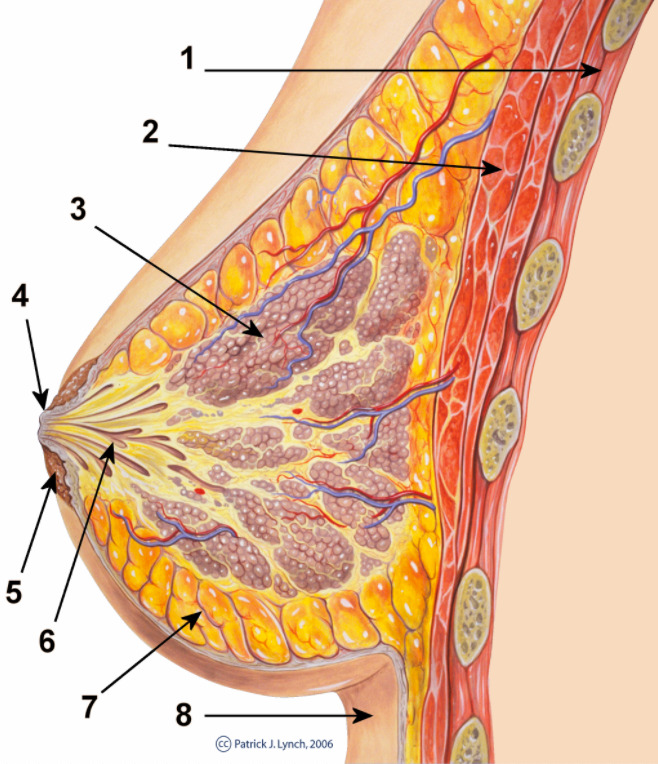Playlist
Show Playlist
Hide Playlist
Mammary Gland – Female Reproductive System
-
Slides 09 Human Organ Systems Meyer.pdf
-
Reference List Histology.pdf
-
Download Lecture Overview
00:00 The mammary gland is a modified apocrine sweat gland. In fact, it really is a number of glands, individual apocrine sweat glands. You see two sections here of the non-lactating mammary gland. On the left hand picture, it’s taken at low magnification. And you can just make out some dense connective tissue, some adipose tissue, and then tiny little profiles of what are terminal ductals, small ducts that remain in a non-lactating breast. And these terminal ducts are shown at higher magnification on the right-hand side of the slide. These terminal ducts under the influence of prolactin, progesterones, and estrogens during pregnancy, are going to develop into the secretory units of the modified sweat gland, the apocrine sweat gland. 01:00 They are going to proliferate and form lobules, acini, secretory units. And then within those secretory units, there’s going to be an intralobular duct that then carries the secretion product towards the nipple where it joins the lactiferous duct. And then the milk is then secreted from that lactiferous duct. And just prior to the exit of the duct in the nipple, there is a little structure out-pocketing called the lactiferous sinus. On this section now low power, you start to see a number of lobules forming. These are individual modified apocrine sweat glands, each with their own duct system, each then opening in through the lactiferous ducts out into the nipple. And under high magnification on the right-hand side, you can see some details of each lobule. And all those secretory units evident there are really just growth of these terminal ducts that remain in a non-lactating breast that have gone through this growth and transformation into secretory units under the influence of various hormones. 02:21 So, in summary, I think it’s important to understand the importance of the uterine tube being both a transport organ for sperm and the oocyte, possibly to bring them together for fertilization. And also the epithelial cells provide nutrition to the environment for those oocytes and sperm and for the fertilized egg. Also, there is this muscular layer around the uterine tube that aids that transport besides the ciliated epithelial cells. 03:06 The endometrium undergoes drastic changes under the influence of estrogen and progesterone. 03:13 Estrogen repairs the lost functional layer of the endometrium after menstruation, and progesterone then stimulates the repaired glandular tissue to start secreting glycogen and other nutrients that are important for the possible implantation of a fertilized egg or a blastocyst. And these changes are all designed to optimize that possibility. 03:45 The cervix optimizes transport of the sperm because the secretory cells secrete a watery mucous at the time of ovulation, whereas, at other times the mucous is very thick and viscous and it is a retaliation for transport of any bacteria and pathogens, and even sperm. 04:06 And the vagina is a protective environment because of the acidity of the lumen produced by the action of bacteria on glycogen produced by the epithelial cells, and it has a wear and tear epithelium because it’s the female copulatory organ. And lastly, the mammary gland is a modified sweat gland. It undergoes dramatic changes during pregnancy, and also during lactation. So thank you for listening to this lecture. I hope you’ve now learned a lot about the organs of the female reproductive system. And I hope you now can appreciate how important it is that all these organs act together in unison under the influence of hormones they produce, but also hormones that are produced by the pituitary gland.
About the Lecture
The lecture Mammary Gland – Female Reproductive System by Geoffrey Meyer, PhD is from the course Reproductive Histology.
Included Quiz Questions
Which of the following is NOT a function of the fallopian ("uterine") tube?
- Maturation of the ovum
- Site for fertilization
- Nutrition of the ovum
- Protection of ovum
- Transport of sperm
What is the function of progesterone following ovulation?
- Development of endometrial secretory activity
- Endometrial repair
- Contraction of myometrium
- Endometrial shedding
- Increased acidity of the cervical lumen
The mammary gland is histologically similar to which of the following glands?
- Sweat gland
- Mucus gland
- Serous gland
- Salivary gland
- Sebaceous gland
Customer reviews
5,0 of 5 stars
| 5 Stars |
|
5 |
| 4 Stars |
|
0 |
| 3 Stars |
|
0 |
| 2 Stars |
|
0 |
| 1 Star |
|
0 |





